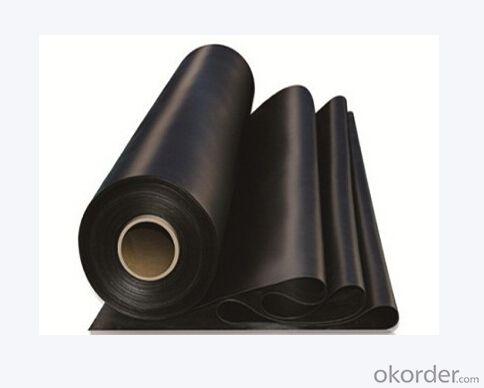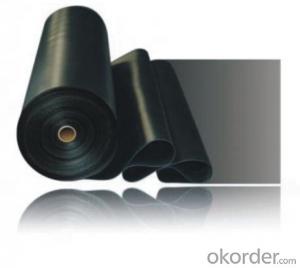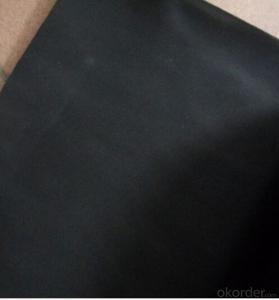EPDM Weldable Waterproofing Membrane for Pond Use
- Loading Port:
- Qingdao
- Payment Terms:
- TT or LC
- Min Order Qty:
- 2000 m²
- Supply Capability:
- 200000 m²/month
OKorder Service Pledge
OKorder Financial Service
You Might Also Like
EPDM waterproofing Rubber membrane
1. Product Description:
EPDM waterproofing membrane is the modified materials. They are based upon EPDM rubber with modifier, softener and accelerant assistants added to provide flexibility and stability . Through the precise ingredients, mixing, extrusion, rolling, curing processes to made of modified EPDM Waterproofing material with high strength and high flexibility.
2. Product Specification:
Type | EPDM Weldable Waterproof Membrane | ||
Material | EPDM Rubber | ||
Thickness | 1.2mm | 1.5mm | 2.0mm |
Weight(kg/m2) | 1.54-1.58 | 1.79-1.83 | 2.25-2.29 |
Size | 1.2m-4m(width) * 20m(length)/roll | ||
Type | Weldable | ||
Pattern | Non-reinforced(homogeneous) | ||
Packing | with plastic bag and then several bags in one pallet | ||
Color | Black | ||
Application | Roof, basement, pond, Lake, steel structure roof, swimming pool, underground, tunnel, etc | ||
There are two installation ways.one is full sticking,the other is hot welding.
3. Technical Data:
1 | Tolerance on size | Thickness | % | ±10 | |
Width | % | ±1 | |||
length | % | Does not allow negative | |||
2 | Fracture tensile strength (normal temperature ) | Mpa | ≥7.5 | ||
Fracture tensile strength(60 degree) | Mpa | ≥2.3 | |||
3 | Breaking elongation,(normal temperature ) | % | ≥450 | ||
Breaking elongation,(zero 20 degree) | % | ≥200 | |||
4 | Tearing resistance | KN/m | ≥25 | ||
5 | impermeability | * | 0.3Mpa impermeable | ||
6 | Bending at low temperature | °C | ≤-40 | ||
7 | Elongation and contraction volume at heating | Elongation | mm | ≤2 | |
contraction | mm | ≤4 | |||
8 | Hot air aging 80°CX168h | Fracture strength retention | % | ≥80 | |
Rate of elongation at break | % | ≥80 | |||
9 | Alkaline (saturated Ca(OH)2 solution normal Temperature x2 168h ) | Fracture strength retention | % | ≥80 | |
Rate of elongation at break | % | ≥80 | |||
10 | Ozone aging (40 degree by 168 hours ) | Elongation 40% , 500x10-2 | * | No Crack | |
11 | Phytotron aging | Fracture strength retention | % | ≥80 | |
Rate of elongation at break | % | ≥70 | |||
4. Product Application:
EPDM waterproof membranes form an effective barrier to liquid water or water vapor in the roof construction for industrial and civil engineering, underground engineering such as subway & tunnel, water conservancy such as water pools & ditch, shelter, grain depot, land filling, dyke and subwayt.

4. Some photos:


RFQ:
What's your payment terms?
T/T ,LC at sight
What's your pacakge?
One roll with one plastic bag, then several rolls in one pallet
What's your delivery time?
One week after received your payment
- Q:Is a waterproofing membrane resistant to extreme weather conditions?
- Yes, a waterproofing membrane is designed to be resistant to extreme weather conditions. It provides a protective barrier against heavy rain, snow, and intense sunlight, ensuring that it remains intact and effective in preventing water infiltration and damage to the underlying structure.
- Q:Can a waterproofing membrane be used in areas with chemical exposure?
- Yes, a waterproofing membrane can be used in areas with chemical exposure. However, it is essential to choose a membrane specifically designed to withstand the chemicals present in the environment. The membrane should have chemical resistance properties and be compatible with the specific chemicals it will be exposed to in order to provide effective protection against water damage and chemical degradation.
- Q:Can a waterproofing membrane be used for outdoor applications?
- Yes, a waterproofing membrane can be used for outdoor applications. Waterproofing membranes are specifically designed to provide protection against water and moisture infiltration, making them ideal for outdoor use where exposure to rain, snow, and other weather elements is a concern. These membranes are commonly used in various outdoor applications such as roofs, balconies, decks, and foundations to prevent water damage and ensure long-term durability. They are highly effective in creating a barrier that keeps water out while allowing the structure to breathe, preventing the accumulation of moisture and potential issues like mold and rot. Overall, using a waterproofing membrane for outdoor applications is a smart choice to enhance the longevity and performance of the structure.
- Q:Can a waterproofing membrane be used for storage tanks or containment areas?
- Storage tanks or containment areas can utilize a waterproofing membrane to prevent water or liquid penetration. These membranes serve as a barrier against such infiltrations and are therefore ideal for containment purposes. Rubber, PVC, or bitumen are commonly used materials for these membranes due to their water-resistant properties. They can be applied either internally or externally to storage tanks or containment areas to safeguard against leaks and moisture-related deterioration. Moreover, the use of waterproofing membranes aids in preventing the development of mold or mildew, thereby ensuring a secure and hygienic environment for stored materials or liquids.
- Q:Can a waterproofing membrane be used for a parking garage deck protection?
- Indeed, the utilization of a waterproofing membrane is a viable option for safeguarding the parking garage deck. Designed with the specific purpose of preventing water infiltration and shielding the underlying structure from moisture-related harm, a waterproofing membrane proves to be highly effective in such scenarios. When applied to the parking garage deck, the waterproofing membrane acts as a barrier, effectively preventing water from permeating the concrete and reaching the steel reinforcement beneath. This, in turn, mitigates the risk of corrosion and deterioration, ultimately prolonging the lifespan of the structure and minimizing the need for expensive repairs or replacements. Moreover, the waterproofing membrane offers protection against other potential sources of damage, including oil or chemical spills resulting from vehicular activity. By creating a barrier, it successfully hinders these substances from penetrating the concrete and causing unsightly stains or deterioration. Supplementary to its protective capabilities, the waterproofing membrane enhances the overall durability and strength of the parking garage deck. It aids in the reduction of cracking, spalling, and other forms of concrete damage that may arise due to freeze-thaw cycles, temperature fluctuations, or heavy loads. All in all, opting for a waterproofing membrane to safeguard the parking garage deck is a highly recommended solution for ensuring the longevity and structural integrity of the facility. By providing a dependable defense against water infiltration, chemical spills, and other potential sources of damage, it serves to decrease maintenance expenses and extend the lifespan of the parking garage deck.
- Q:How does a waterproofing membrane adhere to the surface?
- A waterproofing membrane adheres to the surface through a combination of mechanical and chemical bonding. The membrane is typically applied using a specialized adhesive or primer that helps create a strong bond between the membrane and the surface it is being applied to. The mechanical bonding occurs as the adhesive or primer penetrates into the pores of the surface, creating a physical bond between the membrane and the substrate. This helps ensure that the membrane is securely attached and able to withstand the forces it will encounter. Chemical bonding also plays a crucial role in the adhesion process. The adhesive or primer contains chemicals that react with the surface, forming chemical bonds with the membrane. This chemical reaction helps create a durable and long-lasting bond that can withstand environmental factors such as temperature changes, moisture, and UV exposure. Additionally, the composition of the waterproofing membrane itself plays a role in its adhesion. Many membranes are made of materials with inherent adhesive properties, such as bitumen or rubberized asphalt. These materials have natural tackiness, which allows them to adhere to the surface without the need for additional adhesives or primers. Overall, the adhesion of a waterproofing membrane to a surface is a combination of mechanical and chemical bonding, achieved through the use of specialized adhesives or primers. This ensures a strong and durable bond that effectively protects the surface from water damage.
- Q:Can a waterproofing membrane be used for convention centers or exhibition halls?
- Certainly, convention centers and exhibition halls can benefit greatly from the use of a waterproofing membrane. These types of structures often feature expansive flat roofs and subterranean spaces that are susceptible to water seepage. By employing a waterproofing membrane, one can effectively thwart water infiltration and safeguard the integrity of the building. Convention centers and exhibition halls encounter heavy foot traffic and are exposed to heightened moisture levels as a result of various events like trade shows, concerts, and conferences. Waterproofing membranes serve as an impermeable barrier that keeps water at bay, thereby guaranteeing the building's durability and longevity. Furthermore, waterproofing membranes can be applied to diverse surfaces such as concrete, metal, and wood, rendering them suitable for the various construction materials commonly found in convention centers and exhibition halls. These membranes can be installed beneath flooring systems, on walls, or as a protective layer on roofs, ensuring comprehensive water protection for the entire structure. Additionally, waterproofing membranes are available in various forms, including liquid-applied membranes, sheet membranes, and spray-applied coatings. This versatility affords the flexibility to select the most suitable type of membrane based on the specific requirements and conditions of the convention center or exhibition hall. In conclusion, a waterproofing membrane is an exceptional choice for convention centers or exhibition halls due to its ability to prevent water penetration, shield the structure from potential harm, and guarantee the building's longevity.
- Q:Can waterproofing membranes be used on concrete tunnels?
- Yes, waterproofing membranes can be used on concrete tunnels. Waterproofing membranes are commonly used to provide a barrier against water infiltration in various structures, including concrete tunnels. These membranes, which can be made of various materials such as bitumen, PVC, or EPDM, are applied on the exterior surface of the tunnel walls to prevent water from seeping through the concrete. By creating a waterproof layer, these membranes help protect the tunnel from water damage, such as corrosion, deterioration, and leaks. Additionally, waterproofing membranes also provide a protective barrier against other potential sources of moisture, such as groundwater or surface water. It is important to ensure that the selected waterproofing membrane is suitable for the specific conditions and requirements of the concrete tunnel, taking into account factors such as the level of water pressure, chemical exposure, and temperature variations. Proper installation and regular maintenance of the waterproofing membrane are crucial to ensure its effectiveness and long-term durability in protecting the concrete tunnel from water ingress.
- Q:Can a waterproofing membrane be used for a fountain waterproofing system?
- Yes, a waterproofing membrane can be used for a fountain waterproofing system. Waterproofing membranes are designed to provide a barrier against water penetration and are commonly used in various applications, including fountains. They can effectively protect the structure and prevent water leakage, ensuring the durability and functionality of the fountain.
- Q:Does a waterproofing membrane prevent water infiltration through concrete or other building materials?
- Indeed, the primary purpose of a waterproofing membrane is to thwart the ingress of water into concrete or other construction materials. It serves as a safeguarding shield that is administered onto the material's surface, creating a layer impervious to water. The composition of this membrane can vary, encompassing substances like bitumen, rubberized asphalt, or liquid polymers. Once installed with precision, it effectively averts water infiltration, thereby safeguarding the edifice against potential water-induced harm or moisture-related predicaments.
1. Manufacturer Overview |
|
|---|---|
| Location | |
| Year Established | |
| Annual Output Value | |
| Main Markets | |
| Company Certifications | |
2. Manufacturer Certificates |
|
|---|---|
| a) Certification Name | |
| Range | |
| Reference | |
| Validity Period | |
3. Manufacturer Capability |
|
|---|---|
| a)Trade Capacity | |
| Nearest Port | |
| Export Percentage | |
| No.of Employees in Trade Department | |
| Language Spoken: | |
| b)Factory Information | |
| Factory Size: | |
| No. of Production Lines | |
| Contract Manufacturing | |
| Product Price Range | |
Send your message to us
EPDM Weldable Waterproofing Membrane for Pond Use
- Loading Port:
- Qingdao
- Payment Terms:
- TT or LC
- Min Order Qty:
- 2000 m²
- Supply Capability:
- 200000 m²/month
OKorder Service Pledge
OKorder Financial Service
Similar products
New products
Hot products
Related keywords




























